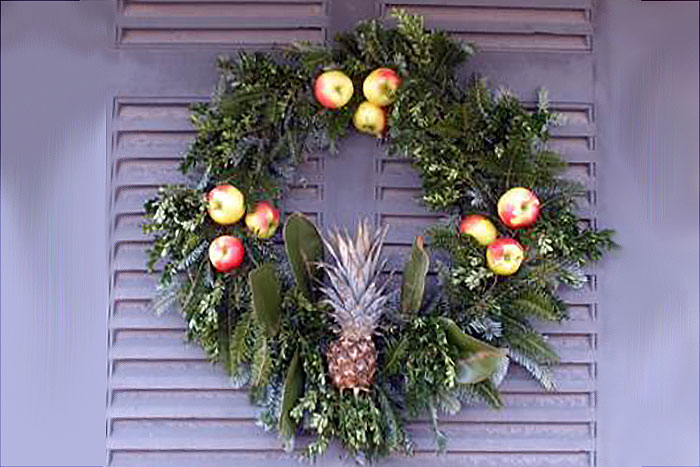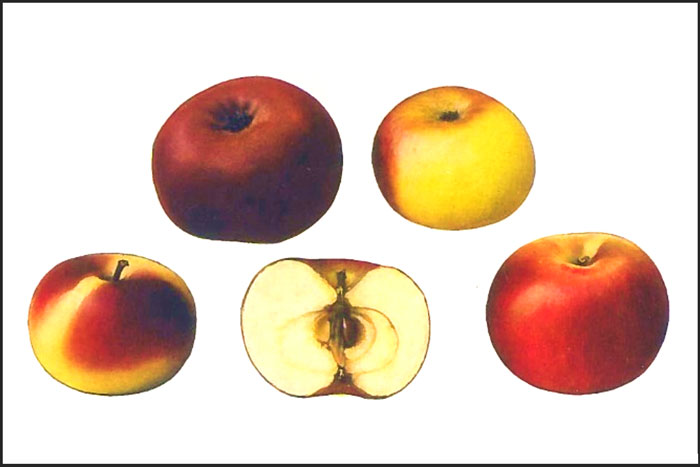Taking an environmentally sensitive approach to pest management
The Christmas Apple
Published: December 4, 2020
In Colonial America, holiday foods and home decorations were often adorned with local plant materials, including apples and nuts. The Christmas apple, a diminutive edible fruit, was one highly-prized apple cultivar. Today, this cultivar is more widely known as the Lady apple and is often available from November through December in local stores. Other common names for this cultivar are Api, Pomme d' Apis, Petit Api, or other derivatives of these names.

Lady apple originated as a seedling from the Forest of Api in Bretagne, France in 1628. Soon thereafter, this cultivar became popular throughout France, England, and America. During the Victorian era, barrels of Lady apples grown in the United States were shipped back to England. Since Lady apples only store well at 34 to 40°F for about one to two months, these imported apples may have been used for cooking, juice, or fermented cider upon their arrival in England. Literature from the 1800's also suggests that this highly aromatic apple was used in homes to mask unpleasant odors, rather like air fresheners are used today. In Robert Hogg's fruit manual, published in 1860, the Lady apple is described as "une pomme des damoiselles et de bonne compagnie", which translates to an apple for ladies and good company.
Well-colored Lady apples have a glossy, ruby red skin, while those grown in shaded areas of the tree often retain a yellow undercolor on portion of the fruit. The flesh is white, pleasantly aromatic, and has a mildly sub-acidic flavor. At maturity, the fruit is about two inches in diameter. However, Lady apples are marketed primarily for their aesthetic qualities, rather than their flavor characteristics. These apples can be used to decorate Christmas trees, wreaths, holiday swags, or table decorations, and are especially charming for historic buildings.

An early illustration of Lady apples published by the New York Agricultural Experiment Station in 1903.
Lady apples have been traditionally used to garnish roasted meats. They are often paired with almonds, chestnuts, walnuts, dates, pears, caramel, bacon and sausage. The flavor of Lady apples is enhanced by baking or roasting, but is not as eye-appealing as it is when used fresh. Like other apple cultivars, Lady can be used in stuffing or chutney to complement pork, ham, or chicken.

Assorted apples and pears used as garnish with turkey. Photo credit: Kevin Lee Jacobs, A Garden for the House.com, https://www.agardenforthehouse.com/2014/11/braeburn-apple-gravy/
Although Lady and Pink Lady apples have similar names, they have dissimilar parentage and fruit characteristics. Pink Lady is the trade name for Cripps Pink apples and originated from a Lady Williams x Golden Delicious cross in Australia. The cross was made in 1973, released for commercial production in 1989, and introduced into the United States in the late 1990's. Pink Lady is a full-sized, elongated apple with reddish-pink with white dots over a green undercolor. It has a sweet-tart flavor with a crisp texture when ripe.
Crabapples are also distinctly different than Lady apples. There are about thirty different species of crabapples, but some of the more common ones are Malus floribunda, hupehensis, sargentii, and purpurea with more than 800 cultivars. Most crabapple trees are grown for their showy flowers rather than the fruit. Crabapples are edible, but most only average one and a half inches in diameter. Depending on the cultivar, fruit ripening occurs from July to November. The fruit is edible, but it is usually tart with a tannic aftertaste. Thus, Hewe's crab (also known as Virginia Crab) fruit is sometimes used to add a tannic complexity to the flavor of hard cider in the United States.

Clusters of ripe crabapples after tree defoliation.
Subscribe to receive similar articles sent directly to your inbox!
- Melons: An August Treat (08/06/24)
- Deck the Halls Safely this Holiday Season (12/04/23)
- Frankincense and Myrrh: Ancient Scents of the Season (12/01/22)
REVISED: December 4, 2020